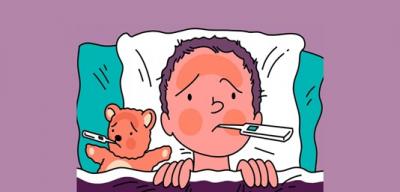Fever: Friend or Foe?
We’ve all lived this scenario: being abruptly woken in the middle of the night by the cries of your child, and you notice that they are hot when you touch them. You frantically search for your thermometer, and the reading sends your heart racing. Your first instinct – call the Pediatrician! But in most cases fever is no reason to panic. Instead, take a deep breath and relax. Fever happens to all of us from time to time. However, fevers in children are often one of the most distressing symptoms to parents.

A recent study in Pediatrics in Review reported as many as 30 percent of all pediatric acute care visits are related to fever. Fever itself is not dangerous and typically causes no harm at all. Quite often fever is actually a good thing – it is a sign that our body’s immune system is working properly to fight off an illness or infection.
Once you recognize that your child has a fever, the most important thing you can do is to improve your child’s comfort and make sure they get enough fluids so they do not get dehydrated. While your first instinct may be to take your child to see a health care provider, it may not be necessary, especially if the child seems fine once the fever and discomfort is managed.
Although every fever does not need to be treated, there are several things you can do to keep your child comfortable.
- Giving your child Tylenol (Acetaminophen) or Motrin (Ibuprofen) will usually reduce their fever. It is important to know their correct dose. It is also important to note that Motrin (Ibuprofen) is only for children older than 6 months of age.
- Dress you child in cool, comfortable clothing. Cold baths and ice packs may actually have an adverse effect on their fever—shivering can increase the body’s metabolic rate and as a result raise the body’s temperature higher.
- Fever will cause children to have higher fluid losses, so offer plenty of fluids to prevent dehydration. Children with fever may not feel hungry and it is not necessary to force them to eat. Instead offer fluids such as breastmilk, formula, milk and water. Older children may eat Jello, soup, or frozen popsicles.
- Having a fever causes most children to feel tired and achy. Encourage your child to rest as much as possible
So, what is a fever and when should you be concerned?
Fever occurs when the body’s internal “thermostat” raises the body’s temperature above its normal level. This “thermostat” is controlled by the part of the brain called the hypothalamus, which regulates our body’s temperature and keeps it around 98.6 degrees Fahrenheit (plus or minus about 1 degree). This hypothalamus will sometimes reset the body to a higher temperature in response to an illness or infection. Because of individual variations in body temperatures, it is difficult to accurately define a fever. However, a fever is generally a temperature above 100.4 degrees Fahrenheit. This number may vary slightly depending on how the temperature is taken—oral (mouth), axillary (armpit), ear, forehead or rectal. Amazingly, healthy children of all ages can tolerate fevers of up to 106 degrees Fahrenheit without any complications. Chances are most children will never approach a fever that high but be prepared. It is almost inevitable that a child’s temperature will climb into the triple digits sometime during the first 3 years of life.
Most of the illnesses that cause fevers—such as colds, Influenza, and stomach viruses—are treatable at home. Seeking care for a fever largely depends on the age of your child as well as other signs and symptoms.
Call your primary care provider urgently if:
- Your child looks very ill, is unusually drowsy or is very irritable/inconsolable
- Has been in a very hot place, such as an overheated car
- Has other symptoms, such as a stiff neck, severe headache, severe sore throat, severe ear pain, an unexplained rash, or repeated episodes of vomiting and/diarrhea
- Has immune system disorders, such as sickle cell disease or cancer, or is taking steroids
- Has had a seizure
- Is younger than 12 weeks of age and has a temperature of 100.4 F or higher
- If fever rises above 104 F repeatedly for any age child
Also call your primary care provider if:
- Your child still “acts sick” once the fever has resolved
- Your child seems to be getting worse
- If the fever persists for more than 24 hours in a child under 2 years of age
- If the fever persists for more than 72 hours in a child older than 2 years of age
As a general rule, remember that fever in children is only one piece of a much larger puzzle. Focus more on the way your child looks and acts overall, rather than on the number on the thermometer. If you have to chase after your child and hold them down to give them fever-reducing medicine, then they probably don’t need it. Letting your child’s fever run its course may actually help the body fight the underlying illness or infection. If bringing down your child’s fever makes them less fussy and encourages adequate hydration, it is fine to do so. But if they are eating, drinking, and playing somewhat normally, then close observation is all that is warranted. And finally, the best management of fever is prevention.
Remember to visit your child’s primary care provider for routine well child care and keep them current on vaccines against potentially life-threatening infections like bacterial meningitis, pneumonia, and Influenza.
